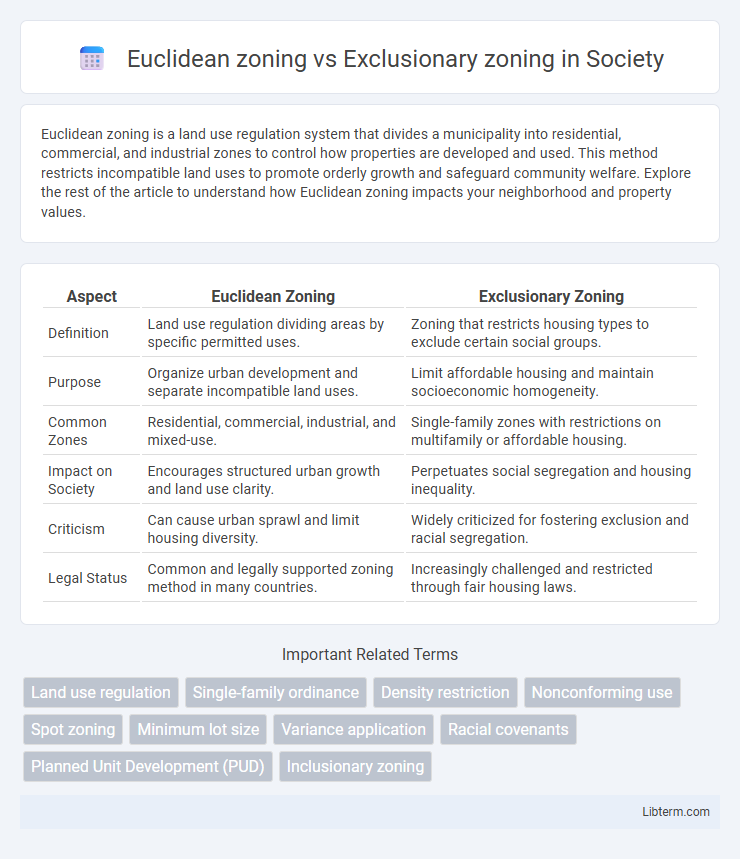Euclidean zoning is a land use regulation system that divides a municipality into residential, commercial, and industrial zones to control how properties are developed and used. This method restricts incompatible land uses to promote orderly growth and safeguard community welfare. Explore the rest of the article to understand how Euclidean zoning impacts your neighborhood and property values.
Table of Comparison
| Aspect | Euclidean Zoning | Exclusionary Zoning |
|---|---|---|
| Definition | Land use regulation dividing areas by specific permitted uses. | Zoning that restricts housing types to exclude certain social groups. |
| Purpose | Organize urban development and separate incompatible land uses. | Limit affordable housing and maintain socioeconomic homogeneity. |
| Common Zones | Residential, commercial, industrial, and mixed-use. | Single-family zones with restrictions on multifamily or affordable housing. |
| Impact on Society | Encourages structured urban growth and land use clarity. | Perpetuates social segregation and housing inequality. |
| Criticism | Can cause urban sprawl and limit housing diversity. | Widely criticized for fostering exclusion and racial segregation. |
| Legal Status | Common and legally supported zoning method in many countries. | Increasingly challenged and restricted through fair housing laws. |
Introduction to Zoning Practices
Euclidean zoning organizes land use into specific, separate districts, such as residential, commercial, and industrial, maintaining order and preventing incompatible uses from adjoining one another. Exclusionary zoning implements regulations that effectively restrict or exclude certain populations, housing types, or income groups by imposing constraints like minimum lot sizes or prohibiting multi-family housing. Both zoning practices profoundly shape urban development patterns, affecting community diversity, housing affordability, and socio-economic integration.
What is Euclidean Zoning?
Euclidean zoning is a land-use regulation method that divides a municipality into specific geographic districts, each designated for particular uses such as residential, commercial, or industrial. This zoning system aims to separate incompatible land uses to promote orderly urban development and public health. Named after the landmark Village of Euclid v. Ambler Realty Co. Supreme Court case, Euclidean zoning has become a foundational model in urban planning across the United States.
Defining Exclusionary Zoning
Exclusionary zoning refers to local land use regulations designed to restrict or limit certain types of housing or demographic groups from specific areas, often by enforcing high minimum lot sizes, prohibiting multifamily housing, or imposing costly building requirements. This practice contrasts with Euclidean zoning, which primarily separates land uses into distinct zones for residential, commercial, and industrial purposes without explicit intent to exclude populations. Exclusionary zoning perpetuates socioeconomic segregation by limiting affordable housing options and reducing diversity within communities.
Historical Context of Zoning Laws
Euclidean zoning, established through the 1926 Supreme Court case Village of Euclid v. Ambler Realty, set the precedent for separating land uses into distinct zones to reduce land-use conflicts and protect property values. Exclusionary zoning emerged as a practice using zoning regulations, such as minimum lot sizes and prohibitions on multi-family housing, to effectively exclude low-income and minority communities from certain neighborhoods. These zoning approaches reflect historical efforts to control urban development, often reinforcing social segregation and shaping patterns of economic inequality.
Key Differences Between Euclidean and Exclusionary Zoning
Euclidean zoning primarily categorizes land into specific zones like residential, commercial, and industrial to promote organized urban development and reduce land-use conflicts. Exclusionary zoning uses restrictive measures such as large minimum lot sizes, bans on multi-family housing, or stringent building codes designed to limit affordable housing and exclude lower-income residents. The key difference lies in Euclidean zoning's intent to separate land uses for public welfare, while exclusionary zoning emphasizes socio-economic exclusion through regulatory barriers.
Impact on Housing Affordability
Euclidean zoning, which separates land uses into distinct zones such as residential, commercial, and industrial, restricts housing density and types, often leading to decreased housing affordability by limiting the supply of diverse and affordable housing options. Exclusionary zoning enforces strict regulations like minimum lot sizes, bans on multifamily units, and restrictive building codes that effectively exclude lower-income residents and reduce affordable housing availability. Both zoning approaches contribute to rising housing costs and socioeconomic segregation by constraining housing development and limiting market flexibility.
Effects on Urban Development Patterns
Euclidean zoning promotes land use segregation by designating specific zones for residential, commercial, and industrial purposes, leading to predictable but often fragmented urban development patterns. Exclusionary zoning imposes restrictions such as minimum lot sizes and prohibitions on multi-family housing, which limit affordable housing availability and contribute to suburban sprawl and socio-economic segregation. These zoning practices collectively influence urban density, accessibility, and socio-spatial equity, shaping cities' growth dynamics and housing market inclusivity.
Legal Challenges and Controversies
Euclidean zoning faces legal challenges for its rigidity and potential to perpetuate socioeconomic segregation by separating land uses strictly, often leading to accusations of exclusionary practices. Exclusionary zoning, which deliberately restricts affordable housing options through regulations like large minimum lot sizes or bans on multifamily units, encounters controversies for violating fair housing laws and increasing housing inequality. Courts frequently scrutinize such zoning policies under the Fair Housing Act and Supreme Court rulings, balancing municipal autonomy with anti-discrimination mandates.
Policy Reforms and Alternatives
Policy reforms addressing Euclidean zoning emphasize mixed-use development and increased density to combat sprawl and promote affordable housing. Alternatives like form-based codes prioritize physical form over land use, creating walkable, adaptable communities that reduce exclusionary practices. Inclusionary zoning policies integrate affordable housing requirements, challenging traditional Euclidean zoning's segregation by income and land use.
Future Trends in Zoning Regulations
Future trends in zoning regulations emphasize transitioning from traditional Euclidean zoning, which segregates land uses into distinct zones, toward more flexible and inclusive models that counteract the exclusionary impacts of single-use zoning policies. Mixed-use zoning and form-based codes are gaining traction, promoting walkable communities and affordable housing by integrating residential, commercial, and recreational spaces. Advances in technology and data analytics further support dynamic zoning approaches that adapt to urban growth, sustainability goals, and social equity considerations.
Euclidean zoning Infographic

 libterm.com
libterm.com